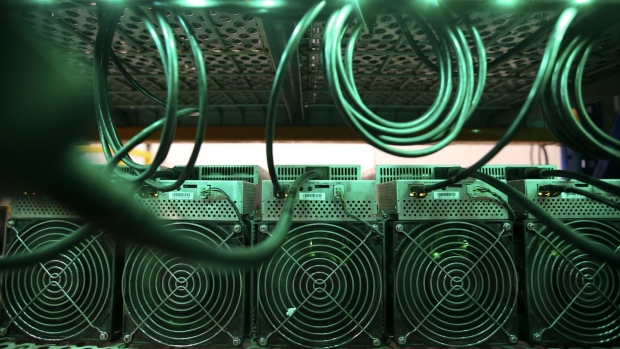May 19, 2023
Crypto Miners Pivoting to AI Cloud Services May Face an Uphill Battle
, Bloomberg News

(Bloomberg) -- Crypto miners looking to provide services for upstarts in artificial intelligence may be looking at an uphill battle, according to analysts.
The opportunity to repurpose a glut of specialized processors — and partner with an industry on the precipice of a boom — represents a huge source of potential revenue. Already, Hut 8 Mining Corp.’s new high-performance computing division has generated more than 20% of the crypto miner’s first quarter sales.
“I think it is possible for miners to be able to reconfigure some of their GPU units,” said Matthew Kimmell, digital asset analyst at CoinShares. “But it’s certainly not going to be simple.”
Very few crypto miners are in a position to build out services for AI, Kimmell said. Only a handful of miners actually have the kind of specialized processors AI requires. Not many will be able to afford the additional investment in hardware and staff after last year’s meltdown in cryptocurrencies. Plus, incumbents like Microsoft Azure and Amazon Web Services will have a lot more runway, he said.
“It is not as simple as mining, you can’t just linearly scale,” said Aydin Kilic, chief executive officer of crypto miner Hive Blockchain Technologies Ltd. “AI needs different servers, motherboards, CPUs, software and more powerful GPUs compared to crypto mining; you are orchestrating the GPUs into a supercomputer.”
Most crypto mining is done using completely different equipment. But a handful of Ether miners snapped up the same kind of high-end GPUs AI uses in 2021 when the soaring price of Ether made miners willing to pay more for the “over-qualified” processors.
The chips have since become useless for mining Ether after the so-called Ethereum merge. And while some miners sold the equipment — which requires constant maintenance and large physical infrastructure — others like Hut 8 and Hive Blockchain have been building out new high-performance computing, or HPC, business lines to service clients from a range of industries including AI.
Hut 8 said gross margin for HPC in the first quarter was more than twice the margin for Bitcoin mining, at 47% and 17% respectively. But that doesn’t take into consideration the initial investments Hut 8 has made to get its datacenters up and running. The company bought TeraGo Inc.’s cloud and colocation business for C$30 million in January 2022.
“The idea that you can just convert a Bitcoin mine as it stands today into a GPU cluster is naive because the demand for GPU-based compute from an environmental, cooling perspective and ultimately what the end customers expect from the uptime and latency perspective is fundamentally different,” Jaime Leverton, Hut 8 chief executive officer, said in an interview with Bloomberg.
Only the biggest miners with experience in GPU-based mining will be in a position to make those kinds of investments, said Ethan Vera, chief operations officer at crypto-mining services company Luxor Technologies. And they’ll be competing with more established cloud service providers also looking to attract AI clients, he said.
Amazon Web Services is working with Nvidia to build out a scalable AI infrastructure optimized for training large language models and developing generative AI applications. Likewise, Microsoft is setting up AI supercomputers to help enterprises train, deploy and scale AI.
Some argue that crypto miners are in a competitive position, though. Chase Lochmiller, chief executive officer of crypto miner Crusoe, said his company was able to be more responsive and create tailor-made data services for AI.
“There are massive cloud computing platforms that have tons of different solutions and they are really trying to be everything for everyone,” Lochmiller said. “We are trying to provide the type of GPU cloud computing that is flexible and very cost-effective, making it easily available especially for the startup community.”
XYZ AI is among the AI startups to have partnered with a crypto miner after considering services from larger incumbents. The UK-based company turned to Hut 8 when it was in need of roughly 200 GPUs to power its AI software that turns text into 3D objects.
“They are nimble and fast enough to actually give us the configuration we need,” the firm’s co-founder Kaya Tilev said. “Our needs are from the technical perspective, and Hut 8 was able to be extremely responsive.”
©2023 Bloomberg L.P.





